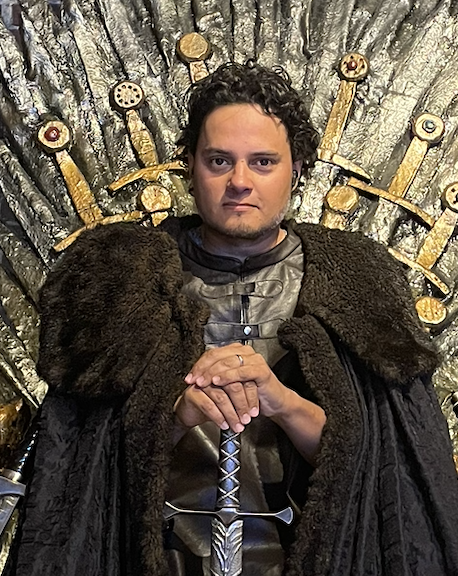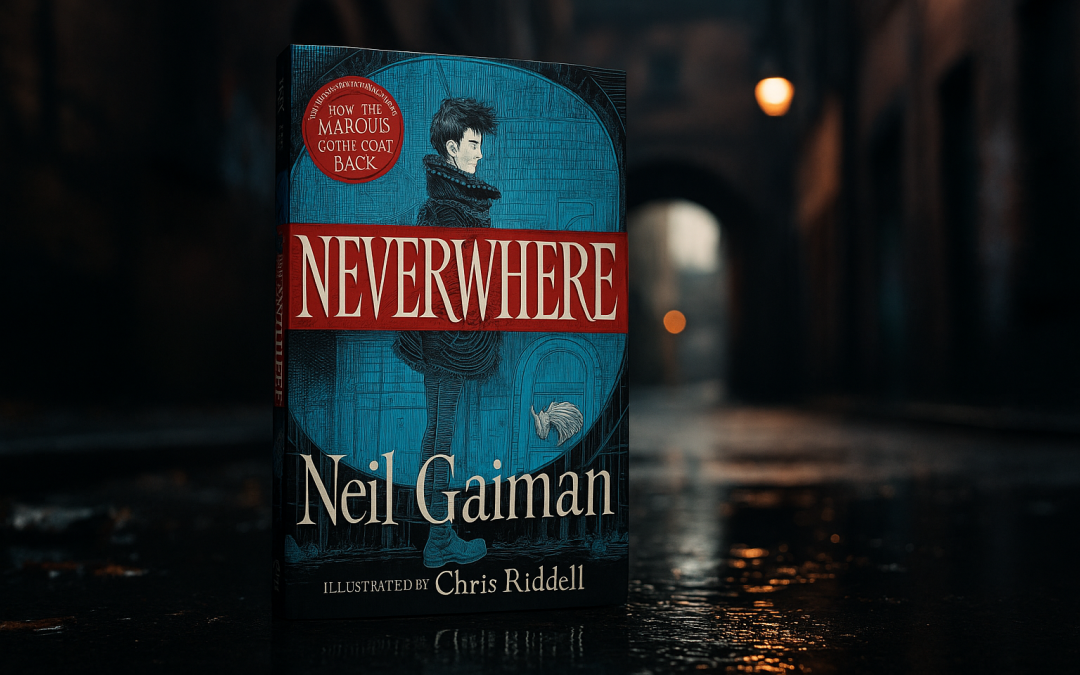What if you fell through the cracks of the city, and discovered a world no one else could see? That question lies at the heart of Neil Gaiman’s Neverwhere (1996), a landmark of urban fantasy fiction that transforms London into a map of the invisible, the forgotten, and the magical. The story follows Richard Mayhew, a mild-mannered office worker whose life changes forever when he helps a wounded girl named Door. His act of kindness pulls him into “London Below,” a shadow city hidden beneath the one he thought he knew. In this world, magic pulses beneath cobblestones, angels walk among the ruins, and the rules of everyday life no longer apply.
Gaiman crafts more than a fantasy adventure. He offers a poetic, sharp exploration of marginality and the politics of urban space. In London Below, people don’t just go unseen; they are forgotten, erased from memory, and lost to the surface world. One character explains, “There are two Londons… and now you’re one of us.” The novel uses this premise to critique the way modern cities obscure those they neglect.
London as a Living Metaphor
Urban fantasy often treats the city as more than a setting. In Neverwhere, London becomes a living metaphor. London Above, filled with rush-hour commuters and sparkling storefronts, reflects the polished surface of modern life. In contrast, London Below exposes what has been hidden, lost, or pushed aside.
When Richard enters Orme Passage, a gas-lit alley tucked behind Oxford Street, he moves from a place of brightness and order into something forgotten. The transition marks a shift in perception as much as space. Gaiman’s storytelling invites readers to question what lies beneath the familiar. In urban fantasy, magic often emerges not from distant lands but from new ways of seeing the world around us.
Metaphor Made Flesh
Throughout Neverwhere, metaphor becomes tangible. Falling through the cracks takes on physical form. Social invisibility becomes literal. Once Richard enters London Below, he finds that others no longer acknowledge him. He cannot hail a cab or buy food. This narrative device highlights the reality of being ignored or erased in urban life. Fantasy, here, reveals the structures many prefer not to see.
Night’s Bridge presents another striking example. Richard must cross a span of total darkness, where fear itself becomes a presence. The trial feels primal and mythic, not just because of its danger, but because it defies reason. Gaiman uses the fear of darkness as a cultural idiom, then transforms it into a lived experience. The bridge acts not only as a location, but as a turning point. Richard begins to shed the illusions of London Above and steps into a reality defined by myth, memory, and emotional truth.
The Floating Market and the Performance of Difference
Richard’s arrival at the Floating Market brings a moment of surreal spectacle. The market appears in disused spaces, such as the abandoned halls of Harrods, and teems with eccentric characters. Punks bargain with mystics; mercenaries chat with monks. Gaiman uses this setting to exaggerate the performance of social identity. What might appear strange and theatrical mirrors the superficial labels and assumptions found in everyday city life.
Richard begins to see that both Londons are constructed from codes and performances. The Floating Market doesn’t just showcase the oddities of London Below. It reflects the layered, often contradictory nature of identity in any urban space. Even the choice of location—Harrods—adds weight to the metaphor. Once a symbol of elite consumerism, the building becomes a chaotic bazaar where difference thrives. The market doesn’t smooth over contrast; it stages it. Through spectacle and improvisation, the marginalised find community and agency.
The Museum of the Forgotten
The novel’s critique sharpens in a scene set in the British Museum. An exhibit titled “Angels Over England” rebrands divine symbolism as corporate aesthetic. Sponsored by a fictional conglomerate, the exhibit transforms angels into decorative icons, flattening spiritual meaning into spectacle. For Richard, now aligned with London Below, this setting evokes unease. Though surrounded by people, he remains unnoticed; his presence is erased by a crowd trained not to see.
This moment critiques more than alienation. It reveals how dominant culture absorbs and repackages belief, history, and identity into sanitized narratives. Where once there was reverence, now there is branding. Gaiman does not simply describe invisibility; he dramatizes it. Through metaphor made literal, the reader confronts how cities determine who gets seen, heard, and remembered.
Descent and Choice
Richard eventually returns to London Above but finds it changed. Or rather, he is changed. The old life no longer fits. He chooses to return to London Below—not as an escape, but as a commitment. He prefers meaning over comfort, agency over invisibility.
His arc contrasts with that of the Angel Islington, a fallen figure who longs to rise again. Where Islington desires power and status, Richard finds purpose in connection and presence. Their opposing journeys reflect the novel’s deeper message: redemption does not lie in ascent. It lies in reimagining what the city—and the self—can become.
Neverwhere exemplifies urban fantasy at its most thoughtful. It blends myth with critique, wonder with insight. Gaiman invites readers to look beneath the surface of the familiar. What we see is a city haunted by memory, structured by exclusion, and pulsing with stories waiting to be told.
Richard Mayhew begins as a man ignored. In London Below, he finds his voice. That is the real enchantment of Neverwhere: it reveals that seeing, and being seen, can change everything.

D.P. Martinez is a contemporary fantasy author specialising in urban fantasy and magical realism. He holds an M.A. in English Literature from the University of Greenwich, where he focused on Literary London. His research explored metaphorical representations of London in urban fantasy. He has written hundreds of articles and several books across both fiction and non-fiction.

